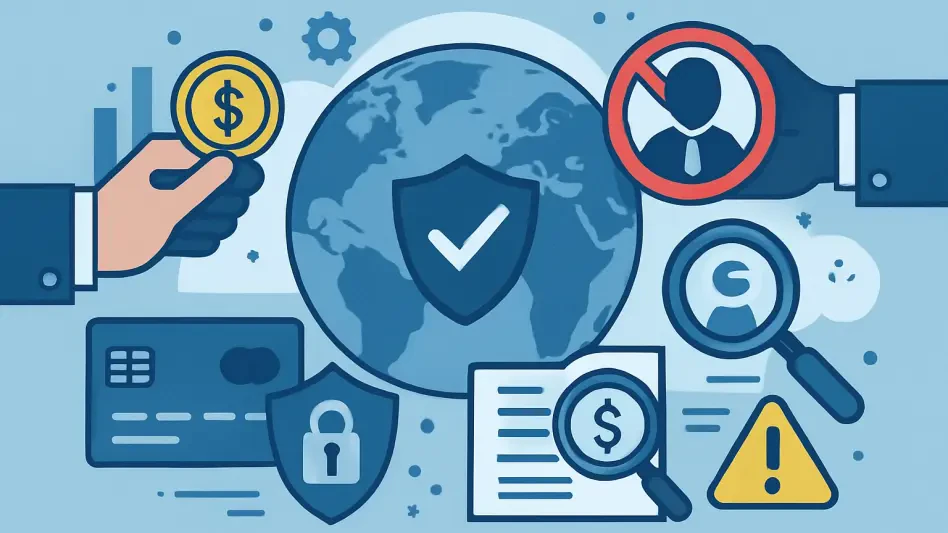In an era where digital connectivity binds the world closer than ever, financial fraud has emerged as a borderless scourge, striking with ruthless precision across nations and demographics, exploiting vulnerabilities in technology and human trust. From seemingly innocuous phishing emails to elaborate schemes orchestrated by organized crime, these threats leave devastation in their wake. Reports from England and Wales reveal a staggering 33% surge in fraud cases in 2024, accounting for 40% of all crimes against individuals, while in the United States, nearly a third of adults encountered fraud attempts in recent years. The complexity deepens with the international scope of these crimes, often rendering traditional responses inadequate. This pressing crisis demands a unified global effort, blending innovative strategies and cross-border collaboration to outmaneuver criminals who thrive in the shadows of jurisdictional gaps. Only through collective action can the rising tide of financial fraud be stemmed.
The Alarming Scale of a Worldwide Crisis
Financial fraud has ballooned into a global epidemic, inflicting profound economic and personal harm on millions. In the United States, data indicates that 31% of adults faced fraud attempts between 2021 and 2023, a stark contrast to lower rates in other regions like Japan, where only 8% reported similar encounters. Meanwhile, the UK grapples with fraud constituting a staggering 40% of crimes against individuals, driven by a sharp increase in reported cases. The cross-border nature of these scams—evident in 70% of UK incidents involving international elements—amplifies the challenge, as perpetrators often operate from distant regions like Southeast Asia. There, scam compounds fueled by forced labor generate billions for criminal networks, exploiting systemic weaknesses and evading local accountability. This sprawling web of deceit not only drains economies but also shatters lives, underscoring the critical need for a coordinated response that transcends national boundaries to protect the most vulnerable.
Beyond the raw numbers lies a deeper, more insidious impact of financial fraud on societal trust and stability. These crimes target a wide range of victims, from tech-savvy youth to unsuspecting elders, exploiting personal data and financial systems with alarming precision. The psychological toll is immense, as victims often face shame and isolation alongside monetary loss, while communities bear the burden of eroded confidence in digital and financial infrastructures. In regions where enforcement lags, such as areas hosting large-scale scam operations, the problem festers unchecked, emboldening criminals to refine their tactics. The sheer diversity of fraud schemes—from fake investment opportunities to romance scams—further complicates detection and prevention efforts. Addressing this multifaceted threat requires not just awareness but a robust, globally synchronized strategy that tackles both the symptoms and the root causes of this pervasive crime wave.
Navigating Law Enforcement’s Uphill Battle
Law enforcement agencies worldwide find themselves outpaced by the sophisticated, transnational nature of financial fraud. Criminals frequently operate from jurisdictions far removed from their victims, exploiting legal loopholes and inconsistent international policies to evade capture. In Western nations, the scarcity of successful extraditions compounds the issue, allowing fraudsters to act with near impunity while victims are left without recourse. The UK Home Office, for instance, highlights that a significant portion of fraud cases involves overseas perpetrators, yet cross-border investigations often stall due to bureaucratic and diplomatic barriers. This fragmented approach reveals a glaring weakness in current systems, where national boundaries become shields for criminals rather than tools for justice. A unified framework is essential to dismantle these safe havens and ensure accountability regardless of location.
Adding to the complexity, the rapid evolution of fraud tactics often outstrips the training and resources available to law enforcement. Scammers leverage cutting-edge technology, from deepfake videos to encrypted communications, to mask their identities and orchestrate attacks at scale. Traditional policing methods struggle to adapt to this digital battlefield, where evidence may reside in multiple jurisdictions or vanish into the dark web. Moreover, the sheer volume of cases overwhelms understaffed agencies, forcing prioritization of larger crimes while smaller, yet cumulatively damaging, scams slip through the cracks. Bridging these gaps demands not only enhanced technological capabilities but also stronger international alliances that facilitate real-time information sharing and joint operations. Only through such collaboration can authorities hope to close the net around elusive fraud networks that exploit global disparities.
Why Defensive Tactics Alone Fall Short
Defensive measures, while indispensable, often prove inadequate in curbing the relentless advance of financial fraud. Public awareness campaigns, alongside significant investments by banks and tech firms, aim to shield potential victims by educating them on common scams and fortifying exploited systems like online banking and telecommunications. In the UK, government-led initiatives have prioritized safeguarding vulnerable sectors, yet these efforts largely focus on mitigating damage after an incident rather than preempting it. Such reactive strategies, though critical for immediate protection, fail to address the core issue: the fraudsters themselves continue to operate unchecked, adapting to new defenses with alarming speed. This cycle of reaction over prevention highlights a pressing need to shift focus toward strategies that directly disrupt criminal activities at their source.
Moreover, the limitations of defensive approaches become evident in the face of increasingly sophisticated scams that bypass even the most robust safeguards. Fraudsters exploit human psychology, crafting personalized schemes that evade detection by security software or public warnings. For instance, social engineering tactics often manipulate trust, rendering even well-informed individuals susceptible to deception. While industry efforts to remove fraudulent content online or enhance transaction verification are commendable, they merely slow the tide rather than turn it. The persistent profitability of fraud ensures that criminals will continue innovating, outpacing isolated defensive measures. A more dynamic approach, integrating proactive disruption with existing protections, is vital to break this cycle and reduce the allure of fraud as a lucrative enterprise. Without targeting the perpetrators directly, defensive walls will remain perpetually under siege.
Harnessing Offensive Strategies for Impact
Turning the tables on fraudsters through offensive strategies offers a compelling path to disrupt their operations and reclaim the upper hand. The private anti-scam community (PASC), encompassing scambaiters, volunteers, and corporate powerhouses like Amazon’s 15,000-member anti-fraud team, has pioneered tactics such as shutting down scam websites and engaging criminals with fake profiles to waste their time. These efforts strike at the operational core of fraud networks, draining their resources and sowing chaos. However, some methods—like hacking into scammers’ systems or publicly exposing their identities—spark legal and ethical debates due to risks of collateral damage, such as misidentifying innocent individuals or inciting vigilante actions. Balancing effectiveness with accountability remains a critical challenge, requiring structured oversight to ensure these bold moves yield results without crossing dangerous lines.
The potential of offensive tactics extends beyond mere disruption, aiming to deter future fraud by making the crime less profitable and more risky. By flooding scam call centers with automated interactions or dismantling their digital infrastructure, the PASC and allied entities create tangible barriers to criminal success. Yet, the lack of formal integration between these grassroots efforts and official channels often limits their impact. Governments and law enforcement could amplify these initiatives by providing legal frameworks that sanction certain disruption tactics while curbing excesses. Additionally, corporate data pools, when shared responsibly, can pinpoint fraud trends and vulnerabilities faster than isolated public efforts. Harnessing this collective energy under a regulated umbrella could transform sporadic victories into a sustained offensive, striking fear into fraudsters who currently exploit the absence of coordinated retaliation.
Forging a United Front Against Fraud
The most viable solution to the global fraud epidemic lies in forging a collaborative framework that unites diverse stakeholders under a common goal. Governments, law enforcement, private sectors, and the PASC must pool their expertise and resources, prioritizing international cooperation to tackle the borderless nature of these crimes. Sharing data across jurisdictions can illuminate patterns and pinpoint fraud hubs, while establishing ethical guidelines for offensive actions ensures that disruption remains lawful and focused. Measures like sanctions—such as asset freezes and travel bans—already effective against other transnational crimes, could cripple fraudsters financially and logistically if applied systematically. This unified approach seeks to erase the safe havens where criminals thrive, creating a seamless network of accountability that spans continents and counters the fragmented responses of the past.
Further strengthening this global alliance requires addressing disparities in capacity and commitment among nations. While some countries lead with robust anti-fraud policies, others lag due to limited resources or differing priorities, inadvertently becoming weak links in the chain. Bridging these gaps through capacity-building programs and diplomatic pressure can ensure a more balanced front. Additionally, integrating community-driven insights from the PASC with official strategies brings fresh perspectives and agility to the fight, countering the adaptability of fraud networks. The use of innovative tools, like cross-border sanctions, sends a powerful message that fraud will no longer be a low-risk, high-reward endeavor. By aligning efforts and fostering mutual trust, this collaborative model promises to not only react to fraud but to anticipate and prevent it, safeguarding global economies and individuals from the relentless ingenuity of criminals.
Reflecting on a Path to Lasting Solutions
Looking back, the battle against financial fraud revealed a landscape marked by escalating threats and fragmented defenses that struggled to keep pace with criminal ingenuity. The staggering rise in cases across nations, coupled with the transnational reach of organized scam networks, exposed the limitations of isolated national efforts. Defensive measures, though vital, often fell short of dismantling the root operations, while law enforcement grappled with jurisdictional barriers that shielded perpetrators. Yet, the emergence of offensive tactics by community groups and private entities demonstrated a potent counterforce, even as ethical dilemmas underscored the need for oversight. Most crucially, the push for international collaboration and sanctions emerged as a linchpin for progress, uniting disparate efforts into a cohesive strategy. Moving forward, the focus must shift to actionable frameworks—enhancing data-sharing protocols, scaling community-driven disruptions under legal guidelines, and pressing for global policies that prioritize fraud as a shared enemy. Only through such sustained, collective resolve can the impact of financial fraud be diminished.








